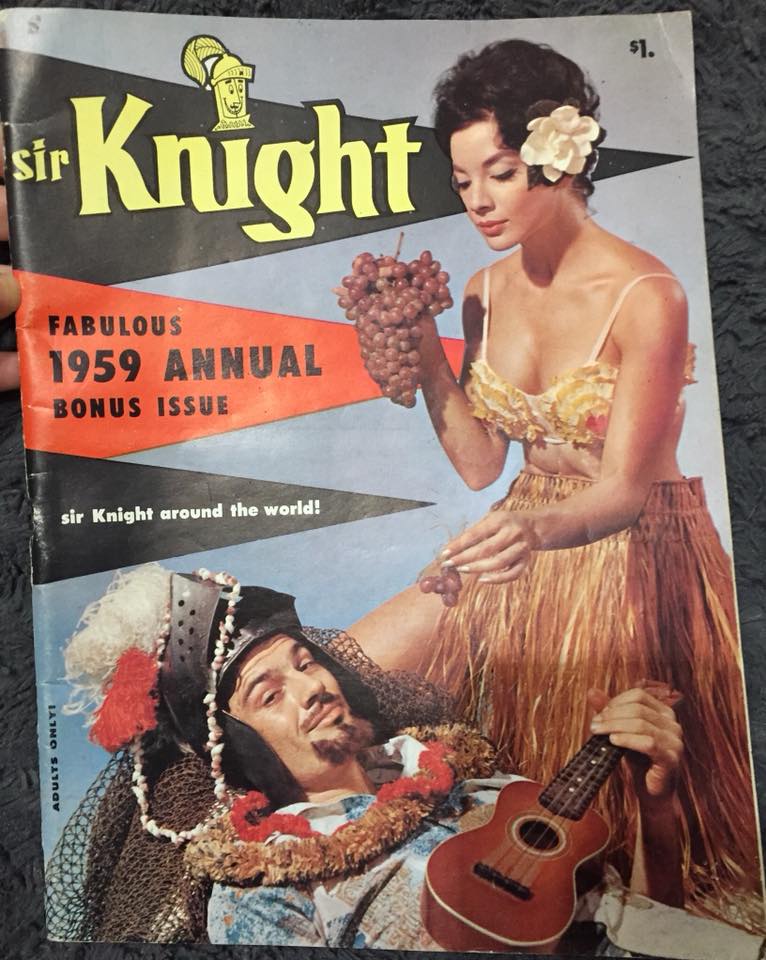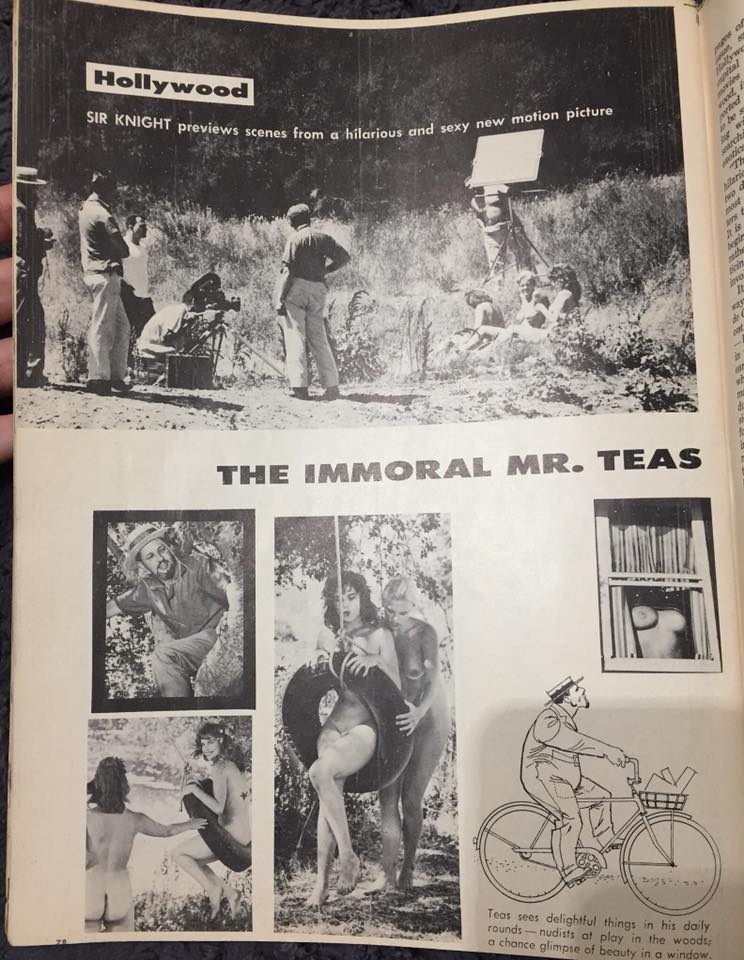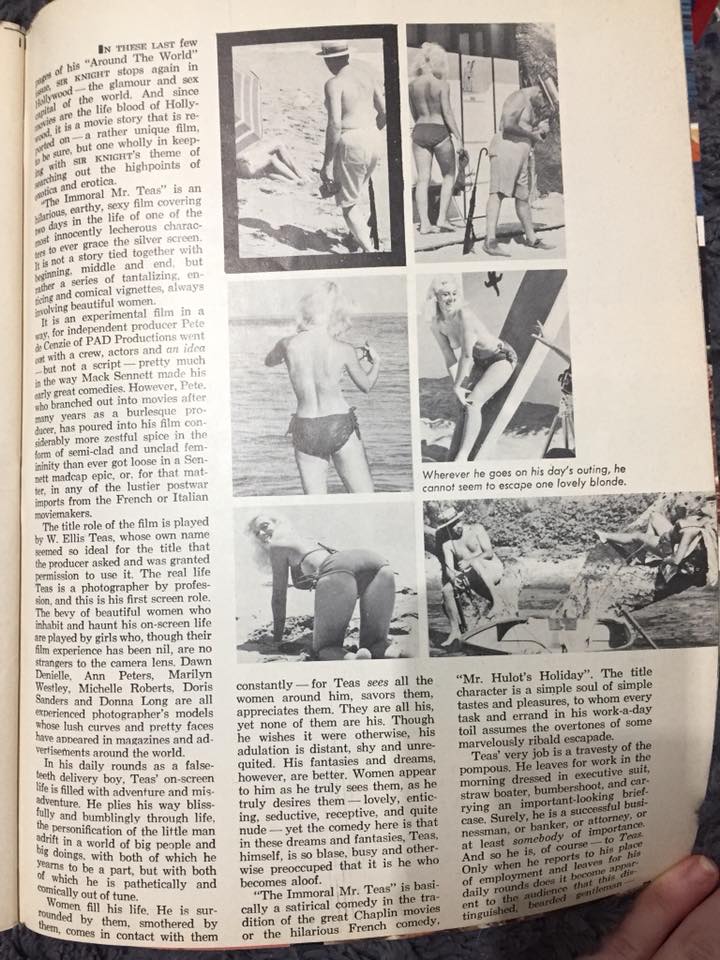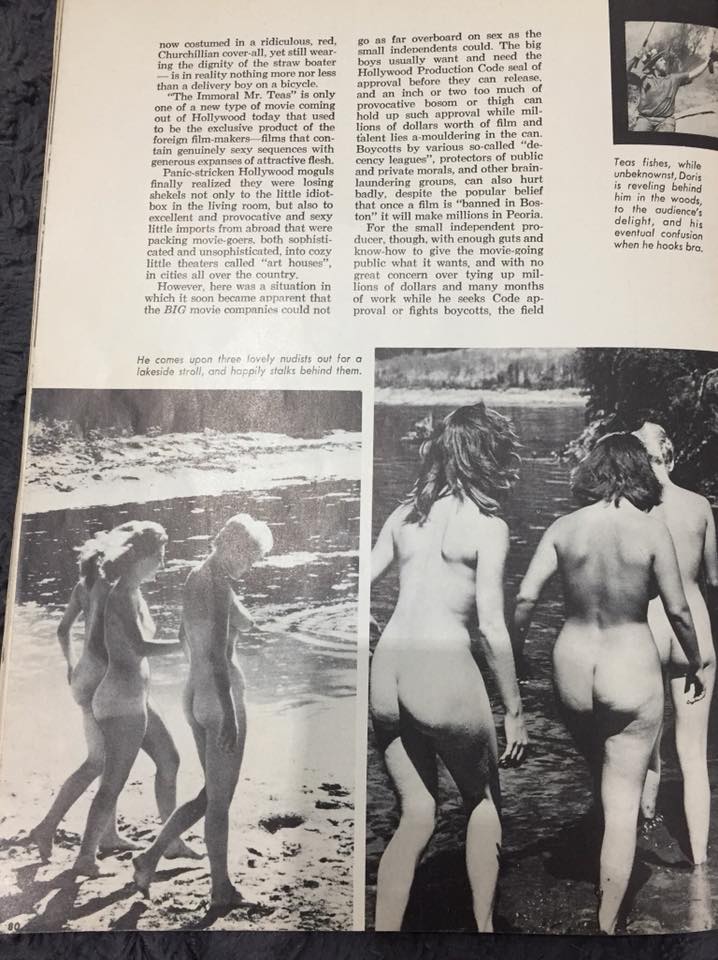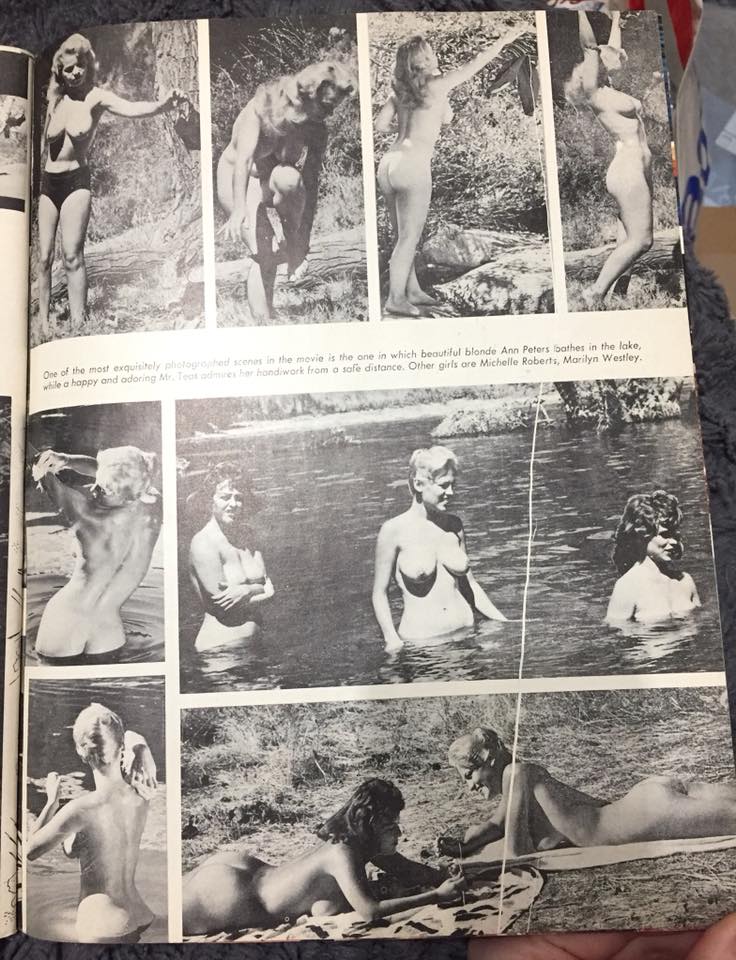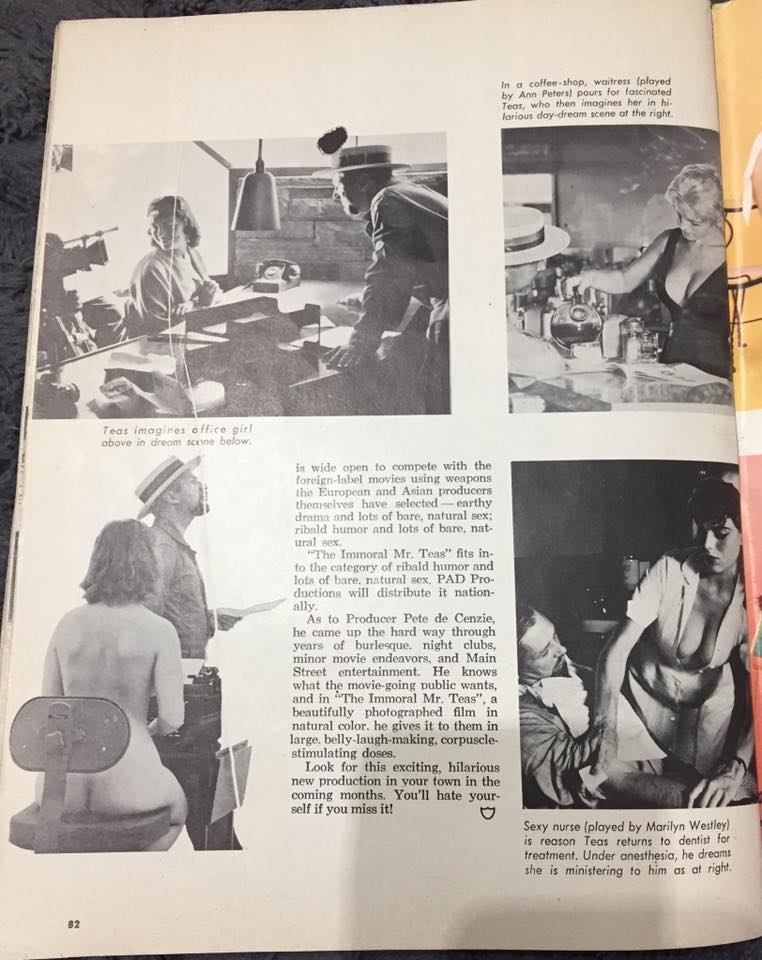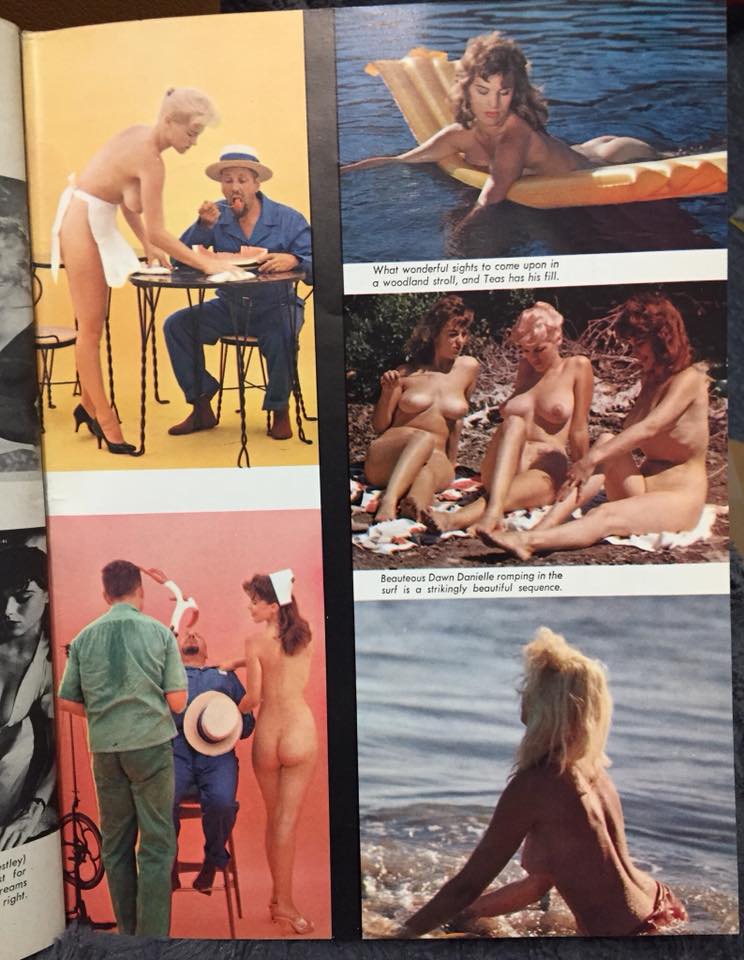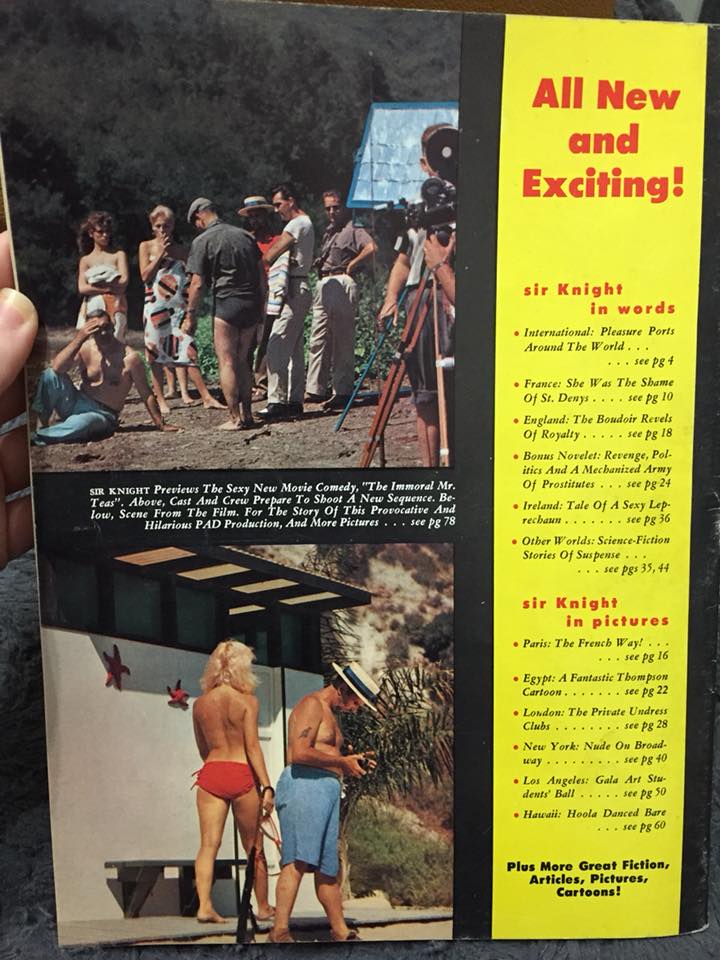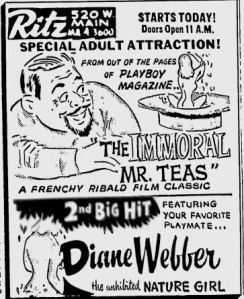Massive thanks to the author of this piece and fellow Russ Meyer fan Justine Smith, who kindly gave me permission to re-blog her article here as part of this years ‘MEYER MONTH’. The original post can be found here, as well as transcribed below.
The Immoral Mr. Teas not only marks the emergence of one of the most interesting and disputed ‘auteurs’ of the American cinema, but also proved to be a crucial film in the emergence of more risqué adult cinema. Not only in terms of exploitation and pornographic cinema, but in paving the way for more lax rules for Hollywood, which was at this point, still stubbornly holding on to the production code. Over the course of the 1960s, the final blows to the production code would take place creating a more liberated cinema and there is little doubt that The Immoral Mr. Teas played a big role in this fight.
After working as a cameraman during WWII, Russ Meyer had returned to California in hopes of getting a job as a cinematographer. He didn’t find any work and turned mostly to work as a freelance photographer (including work for Playboy), occasionally picking up jobs shooting industrial films, as well as more salacious work doing cinematography for burlesque and naturalist films. The naturalist films of the 1950s were really the precursor of the sexploitation films. They were able to be made due to a loophole in obscenity laws, and filmmakers were able to present nudity under the guise of documentary, making films in nudist colonies. These films had little substance and hold little interest today aside from being an interesting historical footnote.
When Russ Meyer was approached to make another film of this type, he initially refused, since they held little interest to him. It was only later he decided to undertake transforming this style of film into a real film that he begun working on The Immoral Mr. Teas. Made for just $24,000, The Immoral Mr. Teas would be the first non-naturalist film since the pre-code era to be released with female nudity. It is often considered the first ‘skin-flick’ and would spurn over the next three years over 150 films in this style. Meyer was relying heavily on the 1957 ruling by the Supreme Court, Excelsior Pictures v. New York Board of Regents, which ruled in favour of the naturalist film The Garden of Eden, stating that nudity was not implicitly obscene. It is important to note though, that Meyer and the films that would follow in the ‘nudie-cutie’ period, did not contain sexual touching or physical contact.
Much like Hugh Hefner, another important figure in breaking taboos, Meyer firmly believed that his sexual fantasies would translate to his audiences and was he ever right. Though the film bears little resemblance to his later, more famous work, his physical type was very much in line with the favourite physical type of the day. All the women featured in the film were extremely large breasted with tiny waists and pretty faces. This ‘style’ of woman is not only reflected on the pages of Playboy magazine, but in the Hollywood stars of the day.
The Immoral Mr. Teas is an interesting film, and though very much a product of its time, has endurance thanks to Russ Meyer’s playful sense of humour. Though the naturalist films served as great inspiration to Meyer, there is little doubt that Playboy magazine has the biggest influence on the film. Critics have argued over the years that the film is little more than a film version of the magazine and the fact that the film has no synch-sound only adds to that impression. There is no dialogue in the film, only a playful narration describing the day-to-day activities of Mr. Teas and the many women he encounters. This is a play on the documentary excuse of the naturalist film, and a fairly clever one at that.
It can also be argued that the character of Mr. Teas is a surrogate for the Playboy reader. It is important to note that it isn’t until the late 1960s and 70s that pornography becomes ‘chic’ and young couples start to attend screenings of films like Deep Throat and Debbie Does Dallas. In spite of the film’s success, the impression of the viewers is no different than that of readers of Playboy: dirty old men. Mr. Teas really epitomizes this vision, and Meyer plays with this further by having the nudity exist only within his imagination. This is not a nudist colony where women are prancing around in the grass, doing day to day activities; the women are not actually naked… except in the surrealist fantasies of Mr. Teas.
Despite some legal problems the film would come to face in various states and cities (the MPAA did not exist at this point, and the state censor boards were still around), it managed to gross over $1.5 million dollars. Its success cannot be over-emphasized, and it became a game-changer in the types of films being made. This is also made possible by alternative theatrical venues that crop up during the mid-1950s, from arthouse to grindhouse. Meyer’s film and others of its type were able to find audiences in these counter-culture institutions. The growing popularity of more ‘adult’ foreign films also contributed to the film’s success, and would later force Russ Meyer to remain competitive and add richer scripts and themes to his work as a means of battling the growing popularity of European cinema in particular.
This particular and early stage of the sexploitation genre would only last a few years. Often referred to as the ‘nudie-cuties’, most were in the ilk of Mr. Teas, featuring non-synch sound, no physical contact and thin plots. Some were just glamorized versions of the naturalist films, adopting the same structure, but with models in the place of real nudists. Though many of these films were rather tame and often dull, Meyer was not the only filmmaker to emerge from this trend as a visionary. His contemporaries included Doris Wishman and Herschell Gordon Lewis, who have since become cult favourites known for their clever sense of humour and, in the case of Herschell Gordon Lewis, an enthusiasm for blood-shed.
The Immoral Mr. Teas may not be as exciting as Russ Meyer’s later work, but it is nonetheless a fun ride. Already at this early stage of his career we have a sense of his vision and the film is far more creative than it has any right to be. The film’s magic lies in the details, from Mr. Teas profession as a salesman of weird objects of dentistry, to the almost Vertigo-like graphics that introduce fantasy sequences. Of course, above all – a certain appreciation of female breasts might help your enjoyment of the film, as they unapologetically make up a large amount of the screen time. Whether or not Russ Meyer interests you as a filmmaker, his incredible influence on the film industry cannot be denied, and this film in particular changed the face of cinema forever.
Justine Smith is a programmer and film critic based in Montreal, QC. She’s the screen editor of Cult MTL and programs the Underground Section for the Fantasia International Film Festival.






